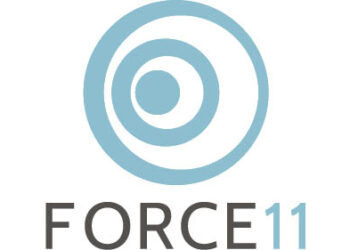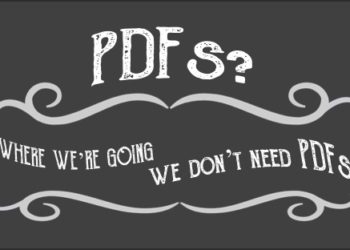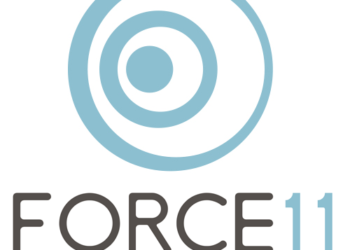There are certainly many benefits to having a routine. We all know when the Society for Scholarly Publishing (SSP) annually meets. There is a cadence to submitting proposals, to setting travel and meetings, then gathering and doing the follow-up. Momentum is supported by this routine and this activity is also important for driving projects forward. For many years, the FORCE11 conference had a similar routine and momentum, with event after event leading to a string of successful initiatives. Like many things during the pandemic, the schedule of in-person conferences organized by FORCE11 was put on hold. Happily, after a successful conference held in Los Angeles earlier this month, FORCE11 is back in a groove. Potentially, a set of project ideas discussed at the meeting can drive continued innovation.
With the generous support of the University of California Los Angeles Libraries, FORCE11’s annual conference reconvened in Southern California after a five year hiatus from in-person events. For the first time, the FORCE11 conference was co-located with the FORCE11 Scholarly Communications Institute (FSCI). Providing a short-form training opportunity for nearly 200 students, FSCI continues a tradition of training opportunities that FORCE11 has offered the community. While smaller and more focused than previous years, the conference was still vibrant with ideas, vision, and energy. Drawing on its original mission to transform scholarly communications, participants envisioned a system that is more community governed, more openly accessible, and more globally inclusive, including more diverse outputs and resulting in greater impact.
Leslie McIntosh and Danny Kingsley in their opening keynote of the conference focused on this important question: what are the differences between “Open Scholarly Infrastructure” and “Open Scholarly Infrastructure” as the emphasis is important as they distinguished it. In their framing, there have been a number of initiatives to support the creation, distribution and discovery of open scholarly content. But over time, it became obvious that these open platforms were not “Open” in the sense that they were private companies that could be bought, sold, or managed to suit the interests of other stakeholders than necessarily the community. Many platforms for open scholarship are run by companies, whose mission may or may not align with principles of “Open Infrastructure” Kingsley and McIntosh argued.
They noted that words such as “sustainability”, “trust”, and “risk” are being featured in marketing language associated with scholarly infrastructure services provided by corporate entities. Kingsley argued that this framing implies that corporate solutions and services are more reliable in that they are inherently more sustainable, and therefore more trustworthy, which she questioned. She continued by reinforcing that this inference implies that those open services not backed by the investments possible from corporate support are therefore less so. In her view, this misses some of the key values associated with open infrastructure, including community governance and control, the ability to adjust and transform the services in a way that meets community needs (as opposed to corporate goals), as well as portability.
Daniella Lowenberg followed this opening with a second plenary keynote that focused on the nuances and reach of open data sharing, from her perspective supporting the open data policies and infrastructure at the Administration for Children and Families (ACF), a part of the Department of Health and Human Services. She focused on the stewardship aspects of maintaining and providing access to federal administrative and research data, ACF’s long history of supporting data sharing and new data strategy, as well as how these activities supports broadening research questions and advancing the policy and programs that ACF serves. Her talk also covered some of the opportunity areas for communities to address, focusing on open data as a public good and the audiences that use it.
While FORCE11 is intentionally a forward-looking organization, often it is useful to consider where we’ve been and how we got to where we are. During the plenaries, Cameron Neylon, Veronique Kiermer, and Geoff Bilder all looked back on what brought us to these crossroads and how these things position us for greater success moving forward.
Throughout his career, Neylon had a hand in a variety of initiatives from the Budapest Declaration, the Altmetrics Initiative, FORCE11’s Manifesto, the Principles of Open Infrastructure, and most recently, the Barcelona Declaration. During his talk, Neylon walked through the various initiatives and described how they tied together to advance a more open ecosystem for scientific communication, each in their own way building upon the others. From his perspective, having been involved in each, he talked through the interests, perspectives, and nuances of each initiative. From his perspective, each built upon lessons learned from the previous work, including the role of community engagement, network building, and the process of trust building among stakeholders.
Veronique Kiermer in her plenary talk discussed the process of open scholarly sharing and how it has grown and adapted over the years. While institutional and funding mandates have impacted the willingness of researchers to share their data, for example, so too have publisher policies. The efforts of publishers like PLOS have advanced compliance efforts through their work supporting the deposit of preprints for authors, as well as data sharing support. She also focused on efforts by PLOS to move beyond articles as a vehicle for communicating scientific findings and developing approaches to assigning credit for these contributions.
Geoff Bilder similarly described the history he had been involved in during his time at CrossRef, describing the contemporaneous launch of Google Scholar, Scopus, and Crossref’s aborted Crossref Search in his talk “Principles of Fauxpen Scholarly Infrastructure“. While he doubted that Crossref could have at the time, or since, run as robust a search service as other companies have, Bilder did posit that any such service that was run by the community would be fundamentally different in meaningful ways. He focused on the community ownership, community involvement, allowances for user portability, and open features of organizations that are features of the POSI principles. After Bilder’s talk, he was joined by Jennifer Lin and Neylon to discuss the impacts of POSI on the community. Their combined perspective on the impacts of POSI and its adoption around the community was enlightening. Open community infrastructure was a theme not only of this talk, but many of the elements of the conference.
Beyond the plenary keynotes, there were more than three dozen other sessions. They covered everything from engaging researchers in open infrastructure, research data citation, AI-assisted tools to improve multimedia visualization, open source software use in research communications, automated labs accelerating science, computational articles and interactive books, reducing retractions, and enhancing transparency in clinical trials. As is often the case, there were too many interesting topics in each session block to capture everything that was being discussed. One conversational session I sat in on was focused on the motivations behind authors submitting their articles to multiple journals. While this is considered inappropriate by many publishers and the COPE guidelines, the session focused on the motivations to do so. Given the potentially slow process of review, revision, and resubmission, considered from a game-theory perspective on the author’s side, multiple submissions has its rationale in terms of optimizing the time to publication in the highest quality publication. It was recognized though that there are external costs to the system and alternate approaches to dissemination were preferred. Another session focused on the process of assigning credit to the infrastructure of facilities and the integration of this process into publication via the through Publish-Review-Curate paradigm developed by the Collaborative Knowledge (CoKo) Foundation. Despite the significant investment in physical infrastructure, such as research facilities, satelites, or computational resources, these investments are rarely tracked in the literature. Potentially, new publishing processes and identification models can improve tracking these significant investments.
The conference ended with a series of workshops focused on specific areas that are nascent and need further development. These included open systems interoperability and data exchange, improving research data services, how research articles should be transformed into packages for research outputs, and the development of a US National Persistent Identifier Strategy. After two hours of discussion, several concrete project ideas were considered for follow-up after the event. These conversations could help propel the next set of FORCE11 working group projects that have been a mainstay of the FORCE11 community since its launch.
While some of us may recall much of this history and change over the past decade or two, certainly many do not. About 40% of the conference this year were first-time attendees. For those not familiar, a bit of history about FORCE11 and its conference is worthwhile.
FORCE11 was formed following a series of meetings in 2009/2010 amongst a group of researchers, publishers, librarians, and software developers to discuss the relatively slow adoption of digital technologies in the decade (at the time) since the widespread adoption of online publishing. There was a sense that academic publishing had moved slowly to adopt digital technologies and that too much scholarly content was still focused on distributing ideas through digital skeuomorph versions of traditional papers in the form of PDF files. Visions of interactive, data-driven, computational science would propel rapid advances in research, while also improving search and assessment. This led a group to create the FORCE11 Manifesto, which propelled its future work and meetings.
Even though many scholarly publishers had moved early to adopt online distribution of content and were quite early adopters of web-based content, many criticized the lack of imagination in the forms and types of content that could be shared online, in the business model approach to publishing, and the metrics by which success in academics are assessed. FORCE11 was organized specifically to advance conversations, but more importantly, actions and models for advancing the state of the art. In the twenty-teens, the FORCE11 conferences were vibrant gatherings of the community to discuss data publishing, software use in research, open access publishing business models, alternative assessment metrics, as well as many other topics. Over the years, many other spaces have become vibrant followers of the path that FORCE11 trail blazed, such as the Research Data Alliance (formed in 2013) and GoFAIR (formed in 2017) among others.
While many organizations support elements of the scholarly ecosystem and strive to bring diverse voices into their ecosystem, few organizations in scholarly communications have success achieving this goal. As an organization, FORCE11 always sought to be very researcher focused, while drawing in the voices of other communities, such as libraries, technologists, and publishers. Much as previous meetings, the various communities were well represented at the FORCE11 conference this year.
Discussions about where to host the next FORCE11 conference and the FSCI rounded-out the meeting. Ideally, the planning will begin for the next conference so the momentum can be sustained.
Discussion
2 Thoughts on "Resetting and Recharging Research Communications in the Sun of Los Angeles: A FORCE11 Conference Report"
Thanks Todd, great to see FORCE11 is back in its IRL groove. I’m particularly interested in the “how research articles should be transformed into packages for research outputs” piece. Would you be able to point me at someone I can contact to follow-up on that? Thanks!
Sorry for the delayed response. This was a discussion led by Veronique Kiermer of PLOS during a workshop on the final day of the meeting. Her thoughts also followed a similar thread of ideas that Anita de Waard from Elsevier and I had during the STM conference this spring.




